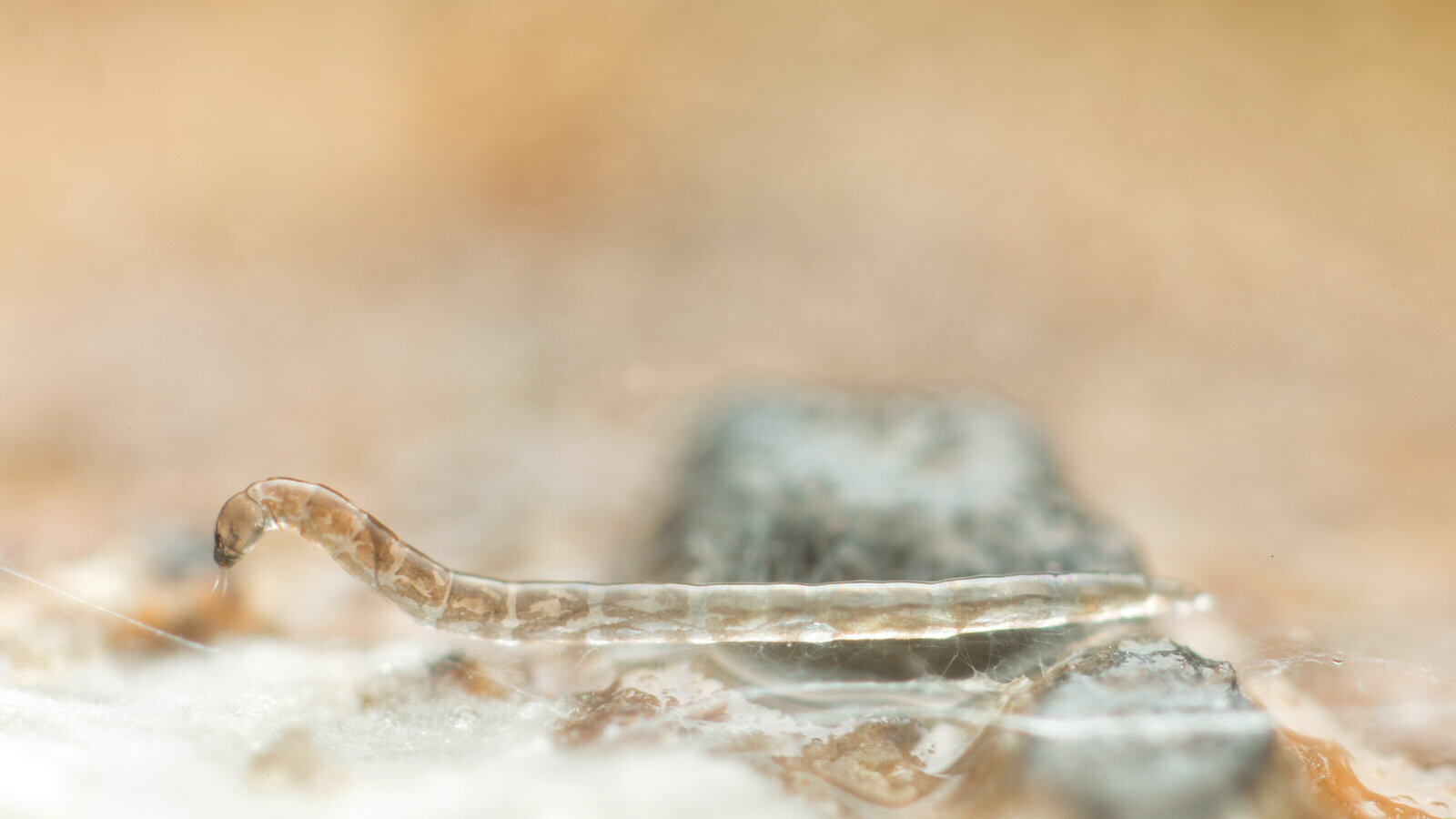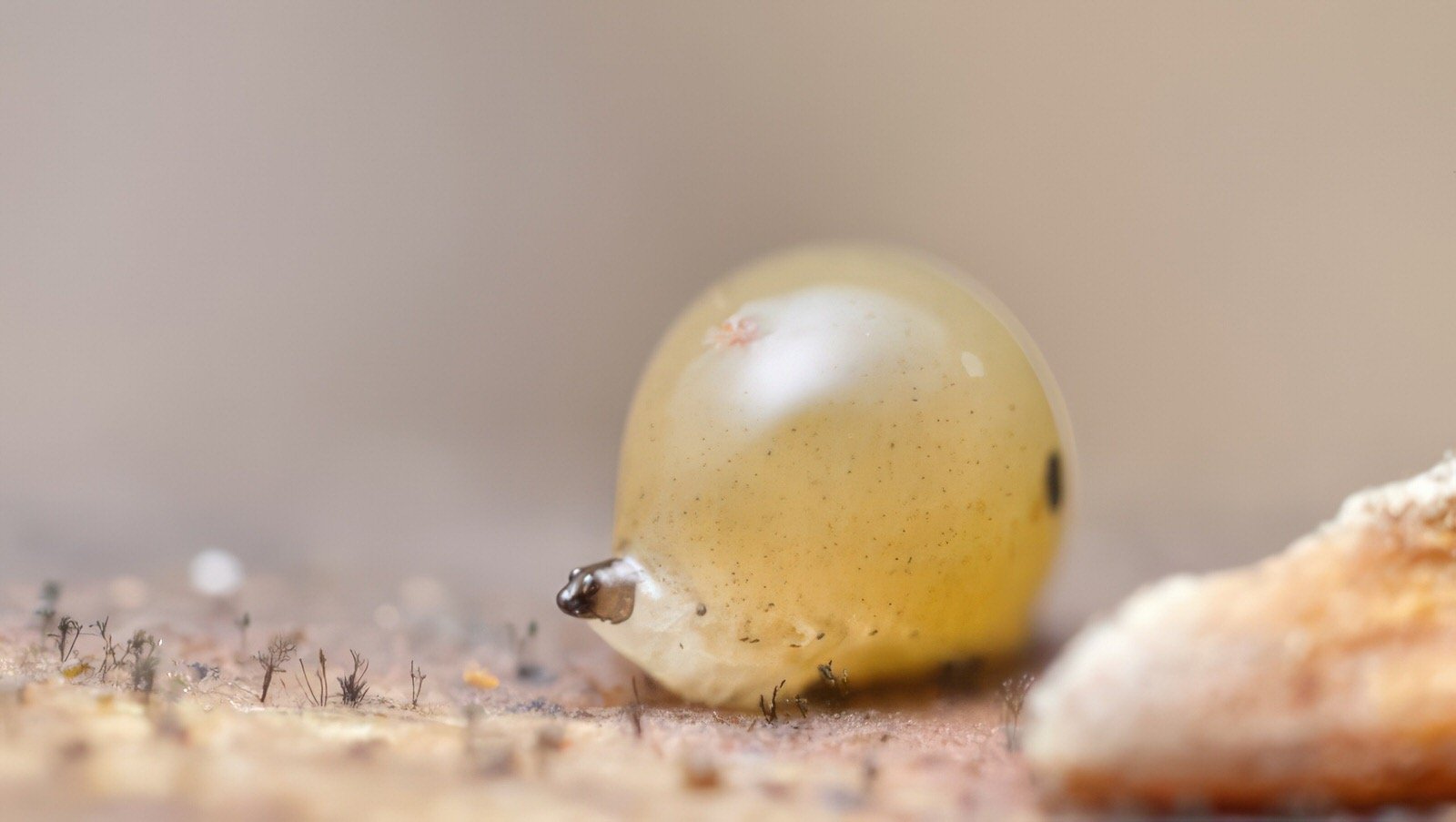
The fungus gnat larvae of Mycetophilidae
Apart from the larvae of Forcipomyiinae, the biting midges- , another very commonly seen larvae in leaf litter and on rotting logs are those of a few subfamilies of the Mycetophilidae, a family of fungus gnats. Their latin name literally means mushroom lovers.
The web-spinning Sciophilinae and Keroplatinae larvae are normally found under bark and fallen logs, living in a semi-manufactured environment, surrounding themselves with a webbing or in a sticky, mucilaginous tube that they travel backwards and forward in. They're slime travellers.
They usually eat fungal hyphae, myxomycetes and spores, although some species are predatory. A noteworthy species is Planarivora insignis, an endoparasite of Tasmanian land planarians.
Certainly in temperate regions, they are also a useful bioindicator of a relatively undisturbed woodland or forest.
Many species of the Keroplatinae subfamily include droplets of oxalic acid amongst their webbing which quickly mobilises and kills small prey, as seen in the photo below.
A Keroplatinae fungus gnat larva with a kill- a pseudoscorpion.
Some Keroplatinae in the genus Arachnocampa in Australia and New Zealand have gone a step further and moved up from the ground to live suspended in caves and under overhangs in dark, humid forests, dangling threads beneath them, loaded with sticky poisonous droplets, fishing for small flies. When one is caught, the thread is pulled back up and ingested along with the fly. As an extra attraction, they are also bioluminescent, with an amazing and distinctive blue-green light. The Waitomo Caves in NZ are world famous because of this and contain mainly thousands of the larvae at one time, lighting up the cave ceilings and tourists’ faces with an unearthly glow.
The photos below show Arachnocampa luminosa, New Zealand’s only representative of the genus, from a patch of native bush in Punakaiki on the South Island of New Zealand. Visually, they are very similar to other Mycetophilidae, with rather pretty patterning. The first photo shows the tube that they live in and coast up and down within, surrounded by threads and droplets. The actual area of luminescence, created by the Malpighian tubules is ringed in the photo, although most traces of luminescence have been obliterated by the flash photography. It’s also possible to make out the three-dimensional structure of the threads, including the added tethers for stability.
I accidentally caught one of the threads of another glow worm with my camera, which meant that the larva came out to investigate and I was able to take photos of the animal itself. After seeing so many Keroplatinae across the world under logs, it was incredible to see their webbing skills adapted in such a way. It’s worth remembering that all the other photos of the Mycetophilidae here are actually photographed upside down, as they would normally be inverted and hanging down from their webbing like A. luminosa, underlining how similar they all actually are.
Some other species in the same group are also able to glow, including some from the UK, although not to the extent of Arachnocampa.
If you pick wild mushrooms, then you will have already come across the larvae from some of the other subfamilies of Mycetophilidae, eating holes and wriggling under the knife or in the frying pan. They are also a common problem in commercial mushroom growing.
Under a log, Franz Josef, New Zealand March 2016
Keroplatinae, like the ones here, have specialised mouthparts, enabling them to spin a sticky web in order to control the humidity of their environment as well as providing some safety against predators. I was lucky enough to actually photograph this happening across the full extent of the web-spinning mouthparts, as can be seen in the photo below. The tiny droplets towards the bottom of the photograph are drops of oxyalic acid.
Keroplatinae can vary quite a lot in colouration and shape, with the distinctive, ‘jointed’ sections and blue and brown pigments of a species from North Island, New Zealand above, compared to a more worm-like pinkish larva from Somerset in the UK below.
Ebor Gorge, March 2018 UK
Under a log, Ebor Gorge, March 2018 UK
The video below shows a Keroplatinae larva spinning some webbing from its mouthparts before turning 180 degrees. it’s a remarkable technique.
The sequence of photos above shows a more detailed example of another species of fungus gnat larva delicately turning in its webbing.
Some other genera in the Mycetophilinae subfamily that also live amongst the rotting wood and fungal hyphae also have some other bizarre adaptations as larvae. This Epicypta species below makes a protective mound or mounds on top of its body, made from its own frass/faecal matter, covered in mucus.
I know.
Larva of an Epicypta species Mycetophilinae Stourhead estate
Larva of an Epicypta species Mycetophilinae Stourhead estate
Larva of an Epicypta species Mycetophilinae, Oxfordshire, UK
Larva of an Epicypta species Mycetophilinae, Somerset, UK
Another, like this Phronia species below collects frass, debris and its own faecal matter and creates a glorious conical structure, indistinguishable from bark until it shifts and lifts and begins to move….
Larva of a Phronia species, Mycetophilinae, Higher Breech woods, Butleigh, Somerset
Larva of a Phronia sp. of fungus gnat, with an upturned ‘shell’, escaping to safety… Stockhill woods, Somerset, UK
Larva of a Phronia sp. of fungus gnat, wild and free and looking like a koala… Stockhill woods, Somerset, UK
Side shot of a Phronia sp. of Mycetophilidae fungus gnat, Stockhill woods, Somerset, UK























